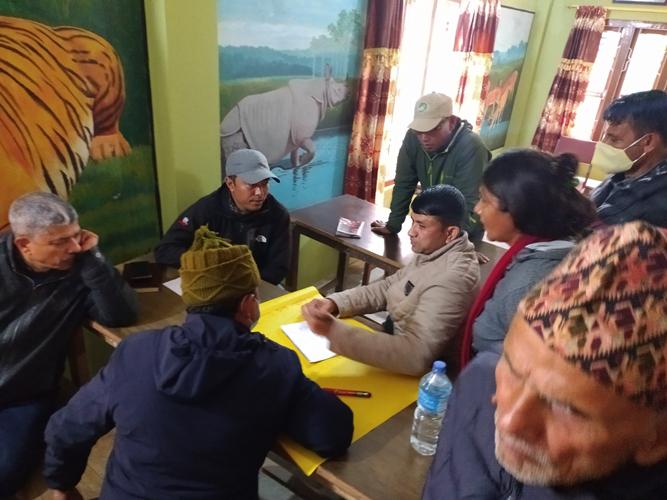Article featuring the project.
What determines attitude of local people towards tiger and leopard in Nepal?
21 Nov 2019 Chitwan National Park, Nepal, Indian Sub-continent Carnivores | Conflict | Mammals
This project aims to contribute in reducing conflicts between human and tiger/leopard in Chitwan National Park and its surrounding buffer zone by strengthening conflict mitigation efforts. It encompasses two components — field-based research and conservation intervention. The project will mainly analyse public perception towards tiger and leopard, evaluate the effectiveness of adopted conflict mitigation measures, prepare conflict management plans for identified conflict hotspots, and conduct conservation awareness programs.

Group work of participants during conflict manangement planning workshop.
Chitwan National Park (CNP) and its surrounding buffer zone harbour the largest population of globally endangered tigers in Nepal and also one of the largest populations of globally vulnerable leopards. Yet, survival of these big cats is mainly threatened by their frequent involvement in conflict, poaching, wild prey depletion, and habitat loss and fragmentation. The conflict with humans could lead to resentment among local communities, retaliatory killings, and reduced public support for conservation of these species. Though various conflict mitigation measures are in place, the issue of human-big cats conflict remains persistent in the park and beyond (Dhungana et al., 2016; Dhungana et al., 2019). Having already explored basic conflict characteristics (e.g. assessment of conflict hotspots, correlates, magnitudes, and economic losses) the way forward for reducing conflict could be both field-based research and conservation interventions. The local perception studies and evaluation of mitigation measures form research-based components whereas preparation of local conflict management plans and awareness programs form intervention-based components.
The perception of local people towards tigers and leopards will be assessed across gender, age, education status, income level, occupation, and ethnicity. The data mainly collected through semi-structured questionnaire survey among local communities will be analyzed using logistic regression models and chi-square tests (Gore and Kahler, 2012; Biru et al., 2017). The evaluation of adopted conflict mitigation measures will be done using data collected from semi-structured questionnaire survey among conflict victims as well as from CNP records. Generalized Linear Mixed Models will be used to identify the effective conflict mitigation measures (Davies et al., 2011). Likewise, local conflict management plans will be prepared in the previously identified conflict hotspots (Dhungana et al., 2018; Dhungana et al., 2019). The plans will be formulated through Appreciative Participatory Planning and Action (APPA) (Jackson and Wangchuk, 2001) by involving conflict-victims, farmers, community groups, and a range of stakeholders. All the analyses will be done in R environment. Additionally, conservation awareness programs targeting grassroots level communities and school students will be conducted in the buffer zone of CNP.
Article featuring the project.
What determines attitude of local people towards tiger and leopard in Nepal?